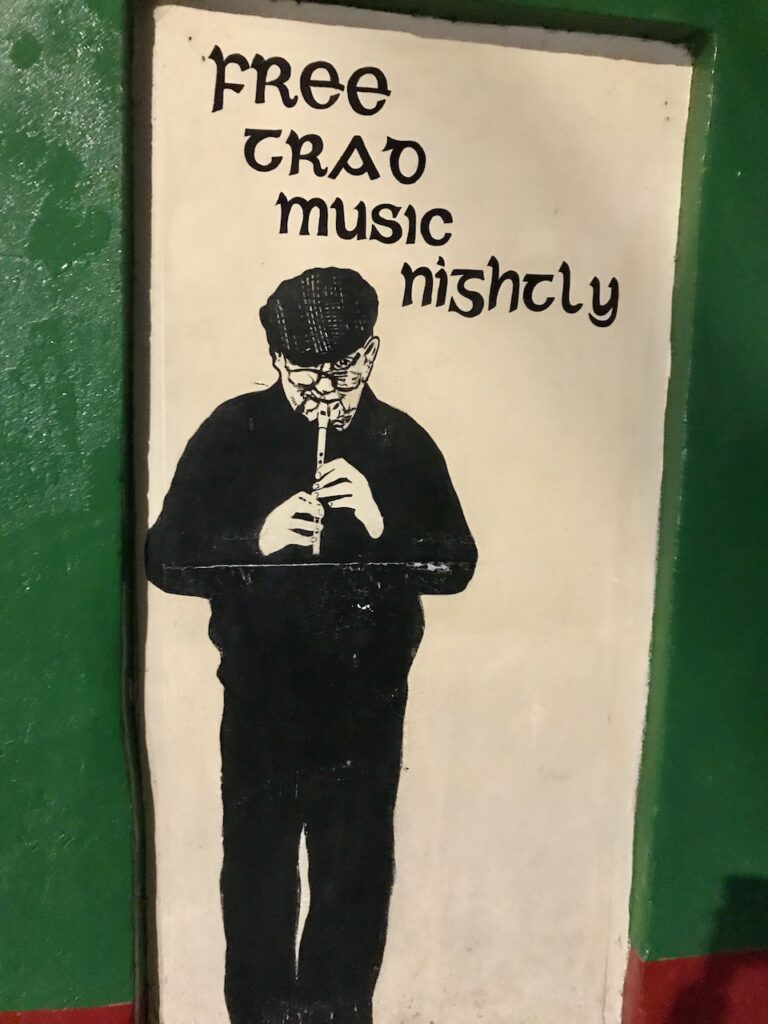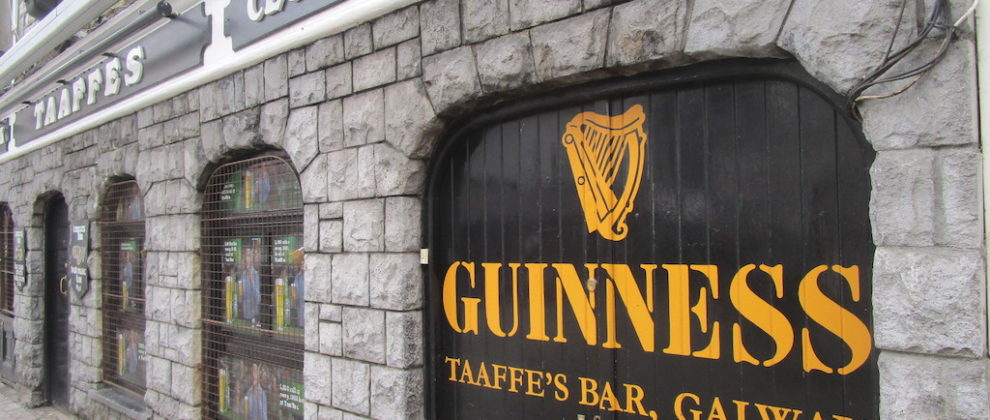
* This is the latest post in a weekly series, highlighting stories from my travel-writing archive with no active link. I’m running them here in full. Subscribe to posts at this website for more. Read another of my stories from Ireland, A Cultural Tour from Belfast to Derry.
It starts with a single rocky outcrop and ends with a scattering of 365 islands.
In between the sweeping County Mayo coastline provides a dramatic counterpoint to the mainly rural inland area where life is slow, Gaelic widely spoken in some areas and the traditions of a bygone era still very much alive. Visitors are the exception here, not the norm.
But that’s all about to change. Word of an ancient folk tale, lost for years and until recently undocumented, is stirring interest in a lesser-known region.
County Mayo, with Westport as its maritime hub, offers a gentle-paced spring escape with relaxed coastal drives, walking on deserted, open beaches and excellent local seafood – all without the hordes of nearby Galway.
It also offers a brush with a pirate queen.
Ship ahoy
The tale revolves around Grace O’Malley, the 16th-century folk heroine, as uncovered by Dublin-based writer, Anne Chambers.
Known as Granuaile (Bald Grace) in Gaelic, a reference to the time she cut off her hair to stow away to sea, her eventful life spanned two husbands, two stints in prison for piracy and numerous seaborne battles at a time when the Machiavellian court of Queen Elizabeth I was seeking to overthrow the Gaelic law of the Irish aristocracy.
The O’Malley clan, with its strong seafaring tradition, dominated County Mayo through trade and force.
Grace, although barred from becoming a clan chief under Gaelic law, readily adopted the mantle of head of the fleet after the death of her father, Owen ‘Black Oak’ O’Malley.
Known as a tactician as well as a fearless warrior, she commanded a flotilla of three galleons and an army of 200 men at the height of her marauding powers.
“I was fascinated as a child by the folklore surrounding Grace and always wondered if she was more than just a legend,” explains Anne, who spent four years painstakingly poring over ancient manuscripts to piece together the true life story of Ireland’s long lost folk heroine.
“She was preserved by Elizabethan state papers and verbal folktales, but ignored by the history books as she was not only a woman, but an outrageous woman. Hence she was systematically written out of the history books for over 400 years.”
Armed with a copy of Anne’s book, Granuaile, Ireland’s Pirate Queen 1530-1603, a sense of adventure to explore the rugged coastal landscape and a taste for a drop of the black stuff, I set out to follow in the footsteps of the woman behind the legend.
Go West
My base was Westport, a genteel little town with two sweeping boulevards of restaurants, traditional high-street traders and cosy pubs. The town makes for a good base to explore the region and feels untroubled by modernity.
To the western fringe of town, close to where Westport Lake opens up into the harbour, I make Westport House the first stop on my quest.
A stately home built in 1730, and still owned today, by the Browne family, direct descendents of Grace O’Malley, the approach is marked by a bronze statue of Grace, who stands guard over the ample grounds.
John Browne III married Maud Bourke, Grace’s granddaughter, to link the two family dynasties, but it was their grandson, John IV, who set about transforming the erstwhile O’Malley castle into modern-day Westport House.
“Grace was a mythical figure, a women out of her time, but as a child, we didn’t talk about her much at home. Before Anne’s book, we had only folk tales, not facts,” explains Sheelyn Browne, Grace’s thirteenth great-granddaughter, over coffee in the library.
“I’m proud to be her descendent. For me, she reflects the natural environment of the West: rugged, wild and uncompromising.”
A short stroll along the promenade from Westport House, the harbour looks south across Clew Bay, offering my first views of the majestic, mist-shrouded Croagh Patrick, the holiest peak in Ireland where St Patrick – allegedly a Welshman, since you ask – banished venomous serpents from Ireland forever.
Island life
I board a small passenger rib that ferries visitors around the sweeping expanse of Clew Bay and chug out towards the island of Carraigahowley.
One of only a handful of inhabited communities amongst the 365 islands in the bay, it’s home to the well-preserved ruins of one of the myriad of castles built by the O’Malley along the west coast.
On a bright morning with sea-spay in my face, the harbour is alive with wildlife: herons, a colony of seals and a last few local colonies of nesting choughs.
Upon arrival, Carraighowley Castle, where Grace sometimes lived, feels a suitably atmospheric liar for a pirate queen with its stone tower, winding, spiral staircase and lofty top floor with slit windows to keep watch over the nearby harbour.
Achill Island, located 30 miles north of Westport, is home to another O’Malley castle, Grainne Uaile, in the village of Kildownet.
A dramatic stone tower looming menacingly over the tiny village, it’s best approached by following the glorious Atlantic Drive. This vista-packed route hugs the coastline and leads, via the surfing beach at Keel and a Blue Flag beach at Keem Bay, to Achill Head, where Atlantic foam crashes against stark rocks.
It feels like the end of the world – and almost is. The next stop is the east coast of America, some 300 miles across the North Atlantic.
But the most evocative location to feel the presence of Grace is Clare Island, just one of three inhabited islands in Clew Bay. Grace grew up here, learnt her seafaring skills in the small harbour and later returned to build her castle on the headland.
Today, Clare Island, a sweep of sandy beach and a workaday harbour with fisherman hauling lobster pots, is deliciously tranquil. I hike along the harbour wall, cutting inland along a flower-strewn country lane in search of the final stop on Grace’s trail, the island’s 12th-century Cistercian Abbey.
Overlooking Achill to the north and the island of Inishturk to the southwest, Grace is allegedly buried here amongst the stone graves having died peacefully in 1603.
Girl power
Grace had travelled to London in 1593 and brokered a deal – woman to woman – with Elizabeth I, allowing her to live out her days in peace, securing the release from prison of her second son and stopping the royal-appointed governor, Sir Richard Bingham, from infringing on her territory.
Some historians suggest that it was her actions, kneeling before the queen and ceding control in the name of peace, which led to her being written out of Irish history.
“She inspired local music, drama and she’s now even on the school curriculum in Ireland. But, most of all, she has finally been written back into history,” says Anne Chambers.
“Maybe she’s the epitome of early feminism – she was as much a matriarch as a warrior.”
As my eyes adjust to the gloom inside the abbey, ancient paintings and murals depict scenes of life: hunting with spears, dragons, greyhounds. On a wall by the altar I find the faded limestone, carved with the O’Malley coat of arms, which marks the end of my quest.
The clan motto, terra marique potens, carved in faded letters, reads, appropriately enough for a pirate queen, “powerful by land and sea”.
* This story was first published in Coast magazine in 2008.
Have you got an angle on a story from Westport, or County Mayo?
Post your comments below.



